With acceptance comes the ability to make change. So, after now two years of having Seamus in our home, I have come to acceptance on a number of things. Most important among these is that Seamus isn’t really a dog. He’s a beagle — and if you know or have owned beagles, then you know whereof I speak. Seamus is a beagle. Big ears, rotten listener.
His past is unknown to us but for snippets, and none of the snippets are very good. He is probably now around 7 or even 8 years old, and we believe we are at least his fourth family, if not his fifth. The poor little guy had no luck when it came to families, and one of the families, for example, simply said that he was too much work and gave him to the rescue group. Another family said their children didn’t like him. It breaks my heart to know that he was treated as though he was simply insignificant.
But, to be fair—Seamus is, well...difficult. While he is affectionate, loving and fun, he will not come when you call him, nor will he “stop” when you say so. He turns nose to the ground on walks and before you can take a breath to say anything, he is sniffing the excrement of some previous beast, or worse, sampling it. Having met with a friend who we see walking from time to time who had treats for him, Seamus believes now that all people with coats on and pockets harbor treats there in. While he’s skittish around dogs (not being one himself…) he loves people and will go up to every single person we see, whether bidden or not, to see if they’ll feed him. He is unvexed if they do not, for he’ll accept a pat on the head or a stroke of the ears happily, and then on again.
He’ll attempt to jump up on the table or counter, even while you’re watching, if something up there smells good. He’s inclined to ask forgiveness, and not permission. When we sit outside, Seamus waits for an empty chair, and then occupies it, dealing in on whatever conversation is at hand. The word “no” is unknown to him, and while he has manners, they are really more for him than they are for us. This evening, for example, it was clear that he wasn’t feeling well and was preparing to hurl. He knew instinctively that doing so in the house isn’t a good idea. Now, I’d like to believe this is because he knows no one wants to clean that mess up. But the evidence argues against this. On one of his first nights here, after all, he took out his frustration on all of the new changes confronting him by dropping a big ol’ Cleveland steamer at the entry to the Master bedroom. His point made, he jumped up on the bed and went to sleep. My stepping in it in the dark and making a sound wasn’t embarrassing to him. Rather, it was frustrating that I’d awakened him.
So, as I say, it’s not about us. He instinctively goes outside to eat grass, do whatever hurling he must do, and come back. This prevents him from stepping in, or otherwise soiling himself, and it gives him more time to climb on someone’s lap when he comes back inside and get sympathy for not feeling well.
Beagles are keenly aware of how they feel and Seamus, at least, works to ensure that any feelings of discomfort are put to rest quickly. To that end, he engages in an activity that is apparently unique among other dogs. It’s something called a “trans-dance.” I looked this up (though it took me a while and no, I don’t remember how I came up on it). Seamus will often walk beneath a pine tree, or sometimes even our bed, and stand there. Occasionally, I’ll see him lift his paw, as if walking in very slow motion. Apparently, this is a self-soothing mechanism for him, and he does it several times a week. I’ve happened upon him just standing under our bed, a tree, a bush and I assumed he was having deep and philosophical thoughts. No such thing—he’s just taking a breather.
Obedience for Seamus is all about what’s in it for him—and if there is food, a treat, a smackerel of something, well then he’ll do it. If I call for him to “come here,” or merely, “come,” I am roundly to be ignored. If, however, the glorious sound of plastic wrap is heard, he will show up faster than a housefly on speed and sit at my feet awaiting whatever morsel there is to be had. One should never mistake a beagle’s arrival at one’s feet as a sign of anything other than he wants something. And that something better be edible. To be fair, though—the beagle will eat almost anything…
A couple of summers ago, my friend Scott was visiting from California. We were barbecuing outside and Seamus was outside with us in the yard enjoying the afternoon and evening. I saw him wander over behind the herb garden and start digging his nose into something. I’d already been used to the idea that he did this, but when he came out with his mouth fully engorged around some tasty tidbit, I yelled, “SEAMUS! OUT!” Most dogs will at least react to that message, but not the beagle. The morsel turned out to be about a day-old baby rabbit. Seamus had sniffed out the den, and while mother was hopping across the yard, at first toward, and then away from Seamus, he found all her little ones and proceeded to devour each one. Before I could get him in the house and block the massacre, he had picked up no less than five kittens and eaten each with a good deal of relish, as though he enjoyed every bite.
Perhaps you’re thinking, “well, surely you worked to keep him away from rabbits then on. You trained him not to go after them, and made it harder for the rabbits to build their dens where he can get them.” I tried—but nothing worked. So, instead I got Seamus a prescription for something called “The Interceptor,” which prevents worms in him should he eat horrid little things. Which he does. Often.
Beagles are not dogs. Oh, they probably come from the canine family. You know, if you’re describing one to an alien, you’re bound to point out that it’s “a dog.” But if so, then it’s a hyper-concentrated dog, a sort of essence of dog, with all of the dog behaviors intensified and none of the more malleable traits emphasized. Me? I align with Mark Twain from one of his stories about a, “long low dog with legs like parentheses turned backwards. He’ll bark steadily all day. At nothing….I don’t b’lieve he was a dog at all…” (First 5 minutes of the video below. Enjoy).
Every piece of advice on training I’ve ever gotten, and I’ve gotten a lot, always ends with, “…but beagles are different. You might not be able to get him to do what you want.” Allow me to assure you that there is no “might” about it. He’s a lovely chap and he wants to be near you, and for that I’m grateful. I like his company. But the only advice about training that has stuck is, “get a good leash, and don’t be tempted to let him off of it when you’re out. Ever.” I have heeded this advice, and have seen the results of what happens when I don’t.
Last spring, I was at the front porch donning my shoes to go for a walk with Seamus. It was cold out, and he had on his winter coat and the leash was attached. My end of the leash was under my shoe as I tied it up, getting ready to go when a rabbit ran by—and Seamus ran after him. The leash slipped from beneath my foot and out he went. We live on a fairly busy road, and he was up the driveway and out to it in seconds. Thankfully, as he ran (and no, beagles cannot run fast. They can, however, run faster than me…) he stayed to the side and away he went, his leash dragging behind him while I attempted to step on it, but he was always a few steps ahead. I’m in relatively good shape, though as I said, I’m not fast. I couldn’t catch him but I kept going. He went nearly half a mile before he was stopped by a neighbor who walks a big rottweiler. Seamus decided it was time to talk to the rotty, and I heard his familiar, “aroooo” as I got closer. The guy had a good grip on the big rotty, and was familiar with Seamus and his shenanigans. So he waited until I got there. I was beyond punishment at that point. I picked up his leash, said, “thanks for not being killed,” and thanked the young man and his rottweiler also for not killing Seamus. And then we went for a walk.
He’s always reacted to other dogs, with a few exceptions. There are a couple that he’ll ignore entirely and also, if he’s otherwise engaged in sweet smells, he can on occasion ignore a dog walking by him. Mostly, though, he announces the other dogs arrival in his sphere of influence with a great deal of fanfare, and vitriol. He strains at the leash and his hackles go up. He’s strong for a 38 lb. animal, and I do have to hang on rather tightly. Pulling too hard, however, will hurt him and so I have to strike a balance between Seamus going ballistic, or breaking his legs. This brings me to last Wednesday’s walk.
We’d gone three miles for a walk through the woods, down to the lake and across the meadow, up the hills on the other side. It was just the two of us on a trail, when I noted that ahead of us, a woman and her large….I mean LARGE rottweiler turned and headed our way. She was a petite and older woman, but she seemed to have a firm grip on Gigantor, there, and so I didn’t despair. But I did ask myself why all of these people up north here have so many rottweilers…
Seamus however, was paying attention and he grew a little more reactive as the giant rotty and his petite owner got closer. She said hello, and I replied in kind and kept Seamus close. We didn’t get far when all of a sudden I heard Madame Petite yell, “Oh, no. SIT!” I spun to look, but it was too late. Gigantor was right behind me. For some inane reason, Mrs. Petite let him off his leash just as she went by us. Seamus was still huffling and making noises, and then—with the rotty sitting right next to me, drooling and staring at Seamus, the beagle let out a great, “arooo,” and started baying at the rotty, who growled with a gleam in his eye and I went for my pepper spray, which I have carried on dog walks for about 10 years now. To be clear, I wasn’t sure that the pepper spray would do anything but anger Gigantor, and maybe cause him to think of me as an antagonist after he snacked on my beagle. But fate turned on her wheel, and the woman apparently had the beast trained well. I walked away from her and as she put a leash back on him, she murmured quietly, “So sorry…” I replied that the leash isn’t always about your dog, it may be about mine!
And so Seamus cheated death for the umpteenth time and I had to continue the trail, already weary, but also wiser. “He’s a reactive dog,” I said to myself.
And then I had to correct myself, of course. “He’s a reactive BEAGLE. He’s not a dog.”
For his part, Seamus sees this as nothing more than a day’s adventure. He came home, we wiped his feet with a towel and he got lunch. Afterward, he came into the living room where I sit now writing this, and plopped himself on his bed. He was asleep in minutes. He’d faced his enemies, been rewarded for his bravery and gallantly walked through forest and meadow, for four miles, leaving his mark as he went to survey and command all that was his. Tomorrow, more rabbits to chase—or not, as he sees fit. More miles to hike, more poo to sniff (or worse…) and more rotties to anger…
Seamus is not a dog. He’s a beagle. He’s a reactive and ornery beagle. Maybe I should start a self-help group for beagle owners. “Hi, my name is Mark, and I have a reactive beagle.” Actually, it’d be more simply and honestly said, “Hi, my name is Mark, and I have a beagle.” Everyone would say, “Hi Mark.” And we’d know we’re there to support each other. And our beagles would not be allowed to the meetings. I suppose I’m a sucker for a hard-luck story, and Seamus has one. As a result, I’m inclined to just smile, give him the benefit of the doubt, apologize for him when he’s rude, and soldier on. He is obstinate, difficult, demanding and at times, rather gross. But he’s my beagle… and I do love him so.
Onward.




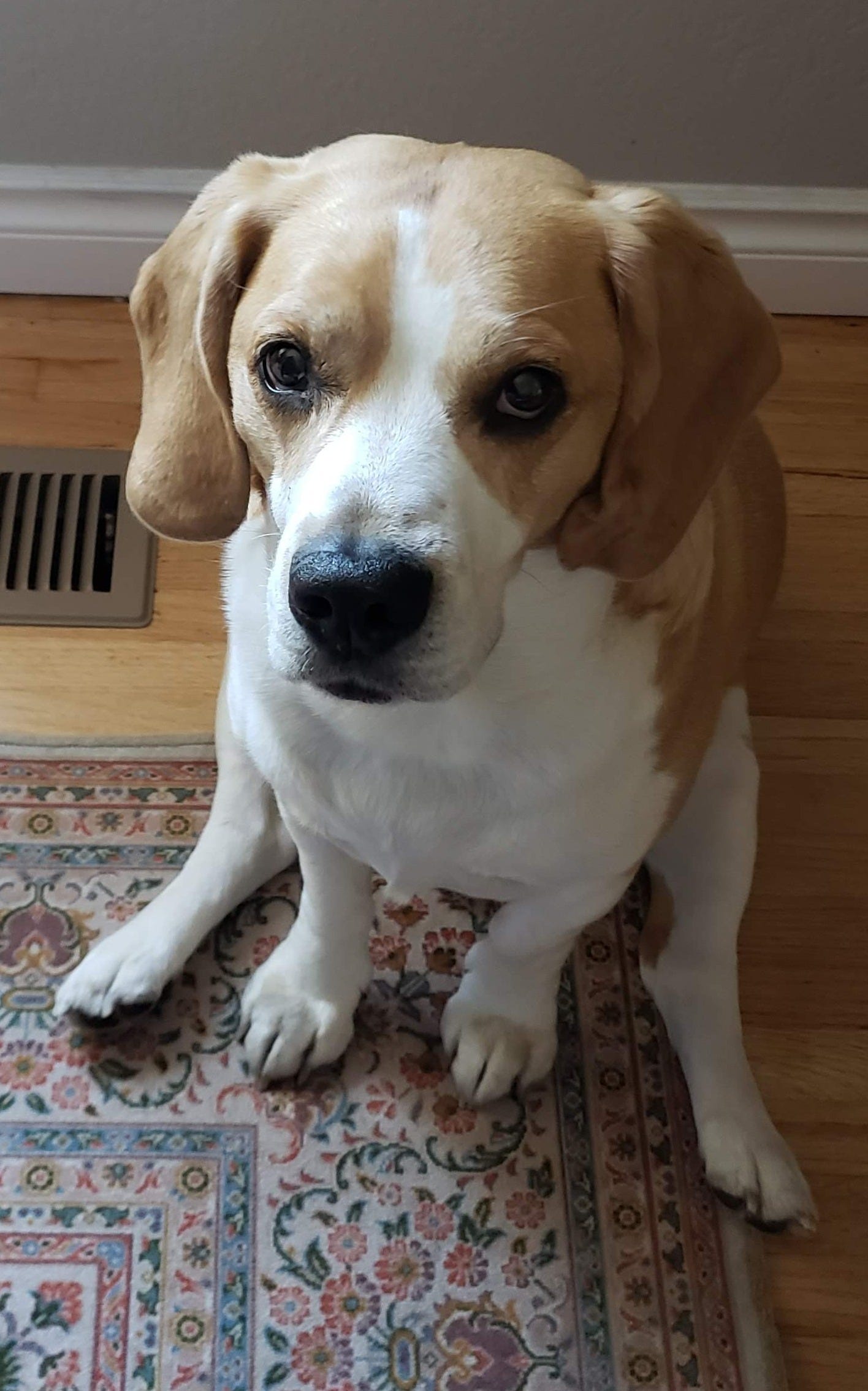

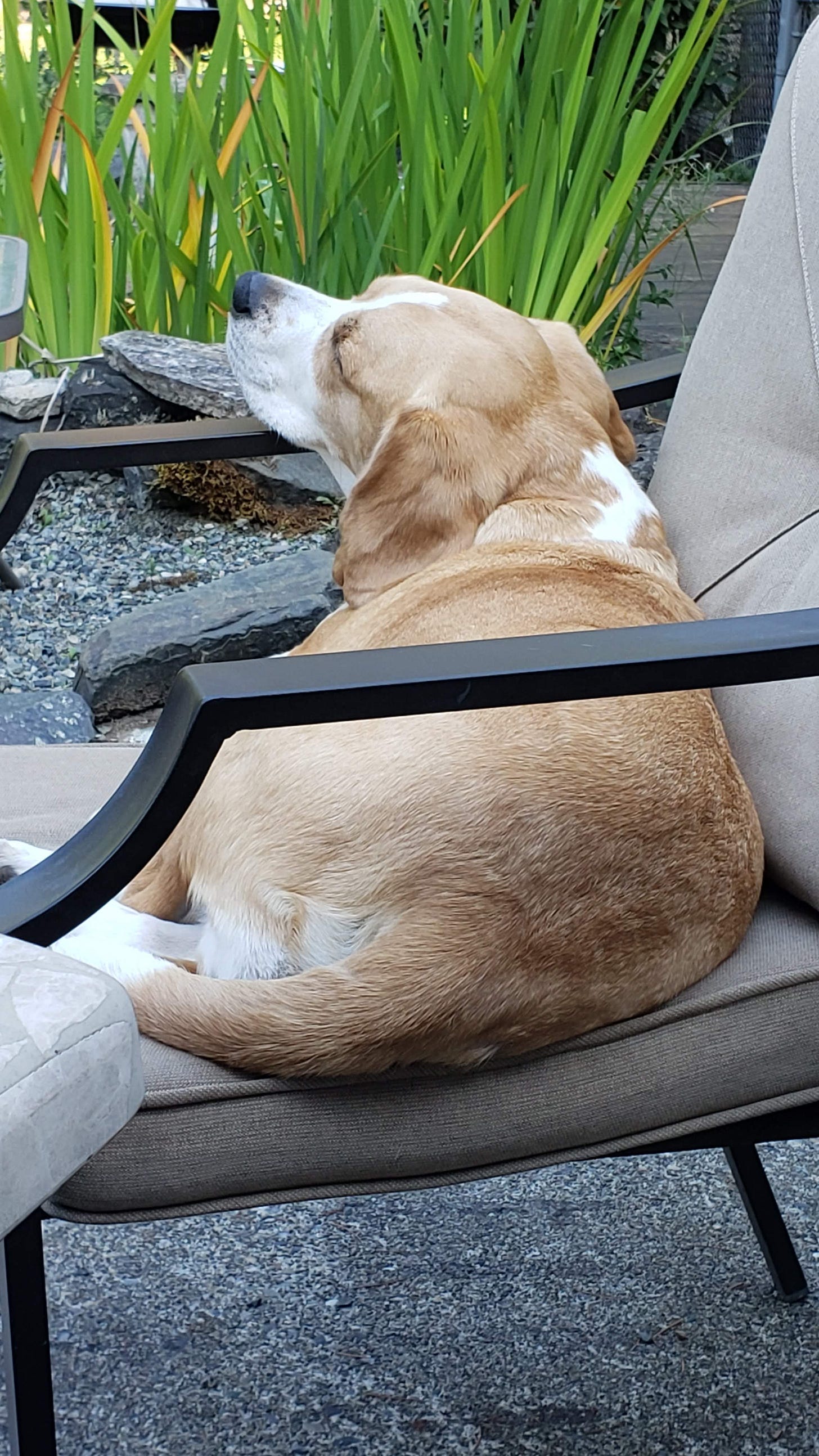
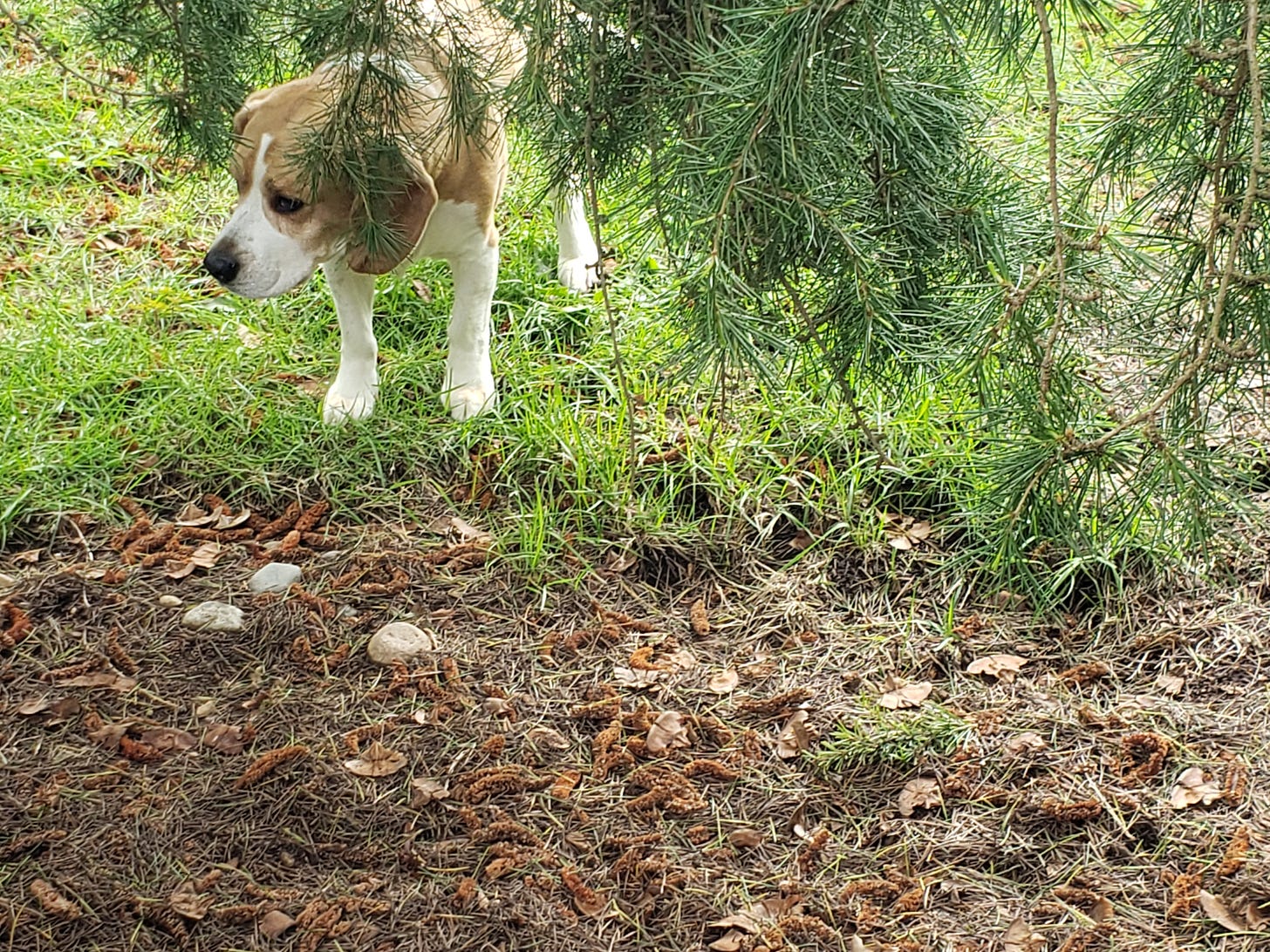

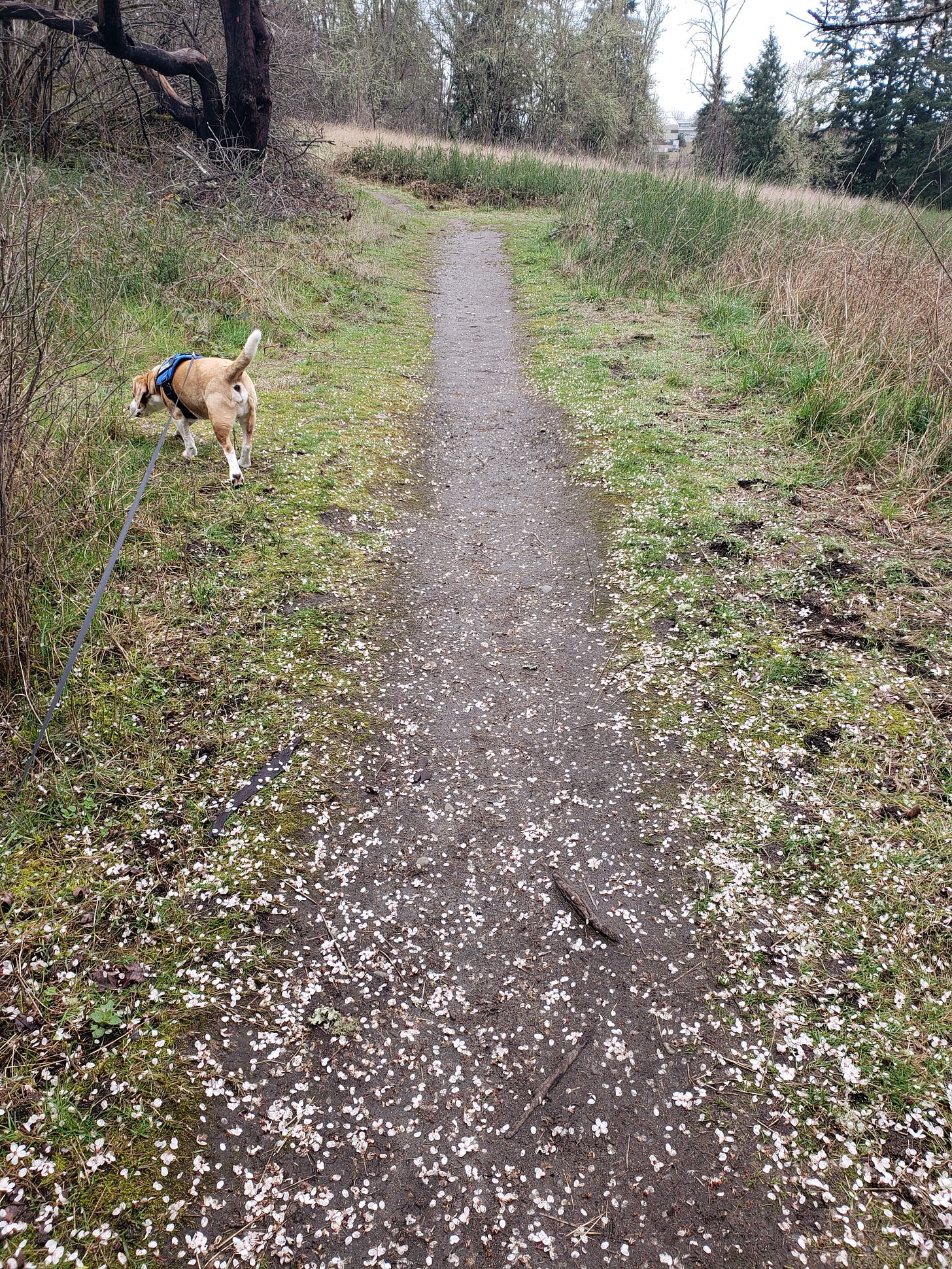
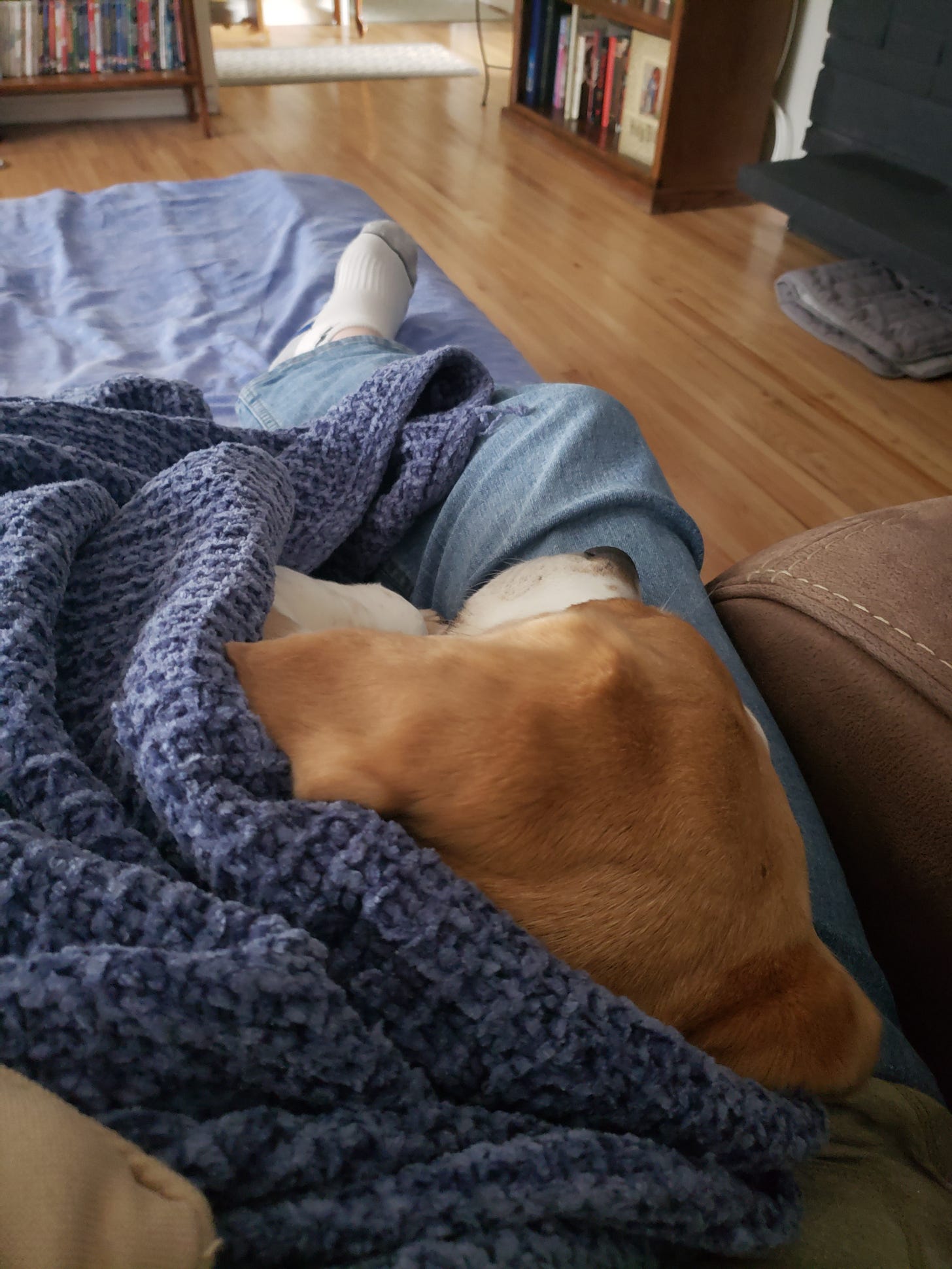
He’s a good boy. All dogs are good dogs.